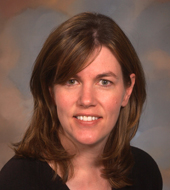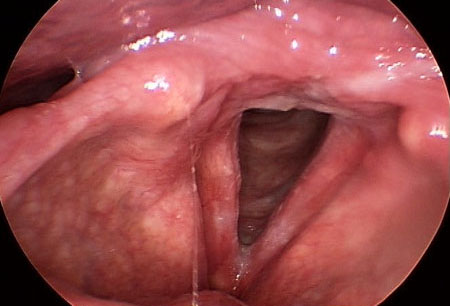Resumo
Definição
História e exame físico
Principais fatores diagnósticos
- presença de fatores de risco
- tratamento prévio para asma sem resposta a broncodilatadores
- dispneia episódica: início e resolução rápidos
- dificuldade para inalar
- tosse
- estridor inspiratório
- aumento da sensibilidade a fatores desencadeantes inespecíficos após exposição inicial
- tensão laríngea palpável
- perda de consciência
Fatores de risco
- refluxo laringofaríngeo (RLF)
- Doença do refluxo gastroesofágico (DRGE)
- asma
- exposição ocupacional/ambiental a irritantes
- sexo feminino
- atividades atléticas competitivas
- ansiedade
- disfonia de tensão muscular
- distonia laríngea respiratória adutora
- cirurgia
Investigações diagnósticas
Primeiras investigações a serem solicitadas
- nasofibrolaringoscopia
- teste de função pulmonar (TFP)/traçado de fluxo-volume
Investigações a serem consideradas
- tomografia computadorizada (TC) dos seios da face
- teste de discriminação sensorial da laringe
Algoritmo de tratamento
Colaboradores
Autores
Rita Patel, PhD, CCC-SLP
Associate Professor
Department of Speech, Language and Hearing Sciences
Indiana University Bloomington
Bloomington
IN
Declarações
RP is on the Board of Trustees for the American Speech-Language-Hearing Foundation, Editor-In-Chief for the American Journal of Speech-Language Pathology, an educational course content developer for Northern Speech Services, and has received grants or pending grants from the National Institutes of Health, and employment at Indiana University.
Susan L. Thibeault, PhD

Professor
UWHealth Medical Director of Speech and Hearing Services
Division of Otolaryngology - Head and Neck Surgery
University of Wisconsin School of Medicine and Public Health
Health Sciences Learning Center
Madison
WI
Declarações
SLT declares that she has no competing interests.
Agradecimentos
Dr Rita Patel and Dr Susan L. Thibeault would like to gratefully acknowledge Dr Michael Johns and Ms Sheeri K. Zelazny, previous contributors to this topic. MJ and SZ declare that they have no competing interests.
Revisores
Julina Ongkasuwan, MD
Associate Professor
Otolaryngology - Head and Neck Surgery
Baylor College of Medicine
Texas Children’s Hospital
Houston
TX
Declarações
JO receives book royalties from Springer and Elsevier.
Janet Wilson, BSc, MD, FRCSEd, FRCSEng
Professor of Otolaryngology - Head and Neck Surgery
Newcastle University
Honorary Consultant Otolaryngologist
Freeman Hospital
Newcastle-Upon-Tyne
UK
Declarações
JW declares that she has no competing interests.
Ryner Jose Dela Cruz Carrillo, MD, MSc, FPSOHNS, FPAHNS
Associate Professor
Department of Otorhinolaryngology
Department of Anatomy
University of the Philippines
College of Medicine
Manila
Philippines
Declarações
RJDCC declares that he has no competing interests.
Tom Murry, PhD
Professor of Speech Pathology
Department of Otolaryngology - Head and Neck Surgery
Clinical Director of the Voice and Swallowing Center
College of Physicians and Surgeons
Columbia University at New York Presbyterian Hospital
New York
NY
Declarações
TM declares that he has no competing interests.
Créditos aos pareceristas
Os tópicos do BMJ Best Practice são constantemente atualizados, seguindo os desenvolvimentos das evidências e das diretrizes. Os pareceristas aqui listados revisaram o conteúdo pelo menos uma vez durante a história do tópico.
Declarações
As afiliações e declarações dos pareceristas referem--se ao momento da revisão.
Referências
Principais artigos
Morris MJ, Allan PF, Perkins PJ. Vocal cord dysfunction: etiologies and treatment. Clin Pulm Med. 2006;13:73-86.
Clemm HH, Olin JT, McIntosh C, et al. Exercise-induced laryngeal obstruction (EILO) in athletes: a narrative review by a subgroup of the IOC Consensus on 'acute respiratory illness in the athlete'. Br J Sports Med. 2022 Jun;56(11):622-9.Texto completo Resumo
Leong P, Vertigan AE, Hew M, et al. Diagnosis of vocal cord dysfunction/inducible laryngeal obstruction: an international delphi consensus study. J Allergy Clin Immunol. 2023 Oct;152(4):899-906.Texto completo Resumo
Artigos de referência
Uma lista completa das fontes referenciadas neste tópico está disponível aqui.
O uso deste conteúdo está sujeito ao nosso aviso legal
